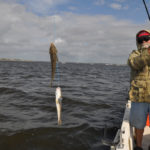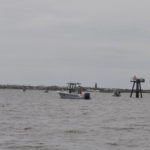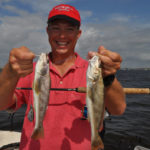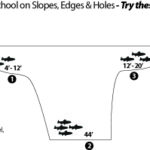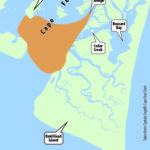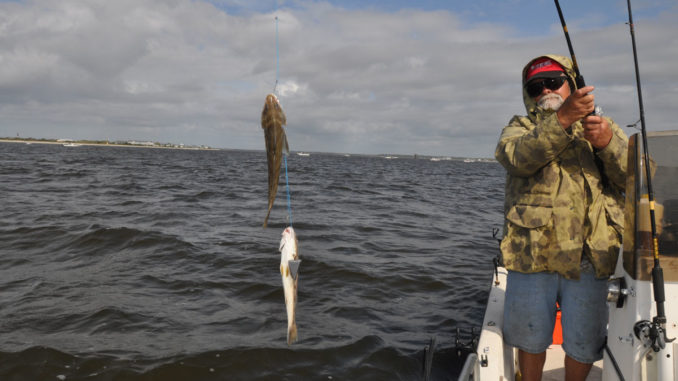
There’s often no rhyme or reason why and where whiting show up in the fall, but you’d better be there.
“The whiting are biting,” said the voice on the telephone. “Want to come along?”
The caller was Capt. Butch Foster of Yeah Right Charters in Southport. When he mentioned the elongated, shiny bottomfish with filets that rival those of a flounder for flavor, the answer was, of course, yes.
Otherwise known as Virginia mullet, sea mullet, kingfish or tiger mullet, whiting are not renowned for their size or fighting abilities. A huge whiting might weigh two pounds, and the state-record fish weighed 3 1/2 pounds. To earn a citation from the N.C. Division of Marine Fisheries, it takes only a fish weighing a pound-and-a-half.
“The reasons you fish for whiting is because you can catch all you want, and they are so good to eat,” Butch said. “They are also so much fun to catch.”
Foster and his son, Chris, launched their skiff at the Oak Island boating access area and made the short trip east along the ICW to what they called the “Spot Grounds.” Several boats were already at anchor, and fishermen were dropping rigs to the bottom and, occasionally, reeling in fish.
“The best place to fish is an area to the east of Marker 16 and north of Fort Caswell, just inside the mouth of the Cape Fear River,” Butch Foster said. “We might catch them shallow or deep. The best depth to try first is from 12 to 14 feet. If you don’t find them at that depth, keep moving deeper and keep watching the other boats as they move all around the navigation markers. They will pack together tighter when one boat starts catching a lot of fish.”
Foster said there is no real trick to catching whiting other than to go fishing when they are in the area. It is determining when they might arrive that proved elusive.
“A small run of whiting can show up at any time,” he said. “They begin building in numbers when the spots arrive in September, and we catch them right along with the spots. By October or November, the spots are starting to move out, leaving the Spot Grounds to the whiting. After that, the whiting move through in surges. Whenever that happens, the fishing can be exceptional.
“The run tapers down the colder it gets, but they can bite to some degree all the way through the winter. If you go after whiting, you will usually catch some even when the water is cold. The really good fishing picks back up again in the early spring.
Foster kept one eye on the other boats and the other eye on his depth finder screen, looking for signs of the fish or baitfish, which he said would show up as clouds hovering along the bottom.
“It looks like some whiting down there on the channel edge at 22 to 24 feet,” he said. “Let’s give it a try.”
Chris Foster cut a shrimp into half-inch pieces and put one of the enticing tidbits on each of the long-shank, No. 6 hooks of a hand-tied, two-hook bottom rig. A 2-ounce sinker sunk the baits to the bottom. It wasn’t long before the rod tip dibbled at a fish’s nibble. He set the hook.
“A double hookup on the first drop of the day. Look at those nice whiting,” Chris Foster said a pair of fish pushing a pound each put a strain on his light spinning rod.
“You can use 15- or 20-pound test,” he said. “It doesn’t matter as long it is strong enough to straighten the hooks out to free them from a snag. There are a lot of shell beds along the channel edges. You snag more structure when you are drifting than when you are anchored up.”
Butch Foster deftly knotted a two-dropper rig on his line, threaded on two hooks and a sinker and began fishing. He reeled in a couple of fish, then nothing.
“The fish move around a lot from day to day, and even from tide to tide during the same day,” Butch said. “You can watch the other boats to see how they are doing, but if you don’t see what you want to see — constant action — the best thing to do is to move around. That’s why I like to start out by drifting.”
Passing several other boats that were having only ho-hum action, Foster fired up his engine and moved from the deeper water to the adjoining, shallower flats. Again, he let the boat drift.
“The wind was blowing northeast yesterday,” he said. “That’s a good wind for whiting because it pushes them onto the shore. Today it’s blowing west or southwest and that could have altered their activity level.”
Foster allowed the boat to drift across the flat all the way to Bald Head Island. Just before he had to move the boat away from the shoreline, his son set the hook and caught a whiting.
“I’ll drop the anchor and we will sit for a while,” he said. “The bottom is sandy here, so we can cast around.”
They fan-casted baits in all directions, checking for the greatest concentration of fish. It wasn’t long before they were bailing whiting, which were coming over the gunwales two-by-two.
“It’s always fun to find your own fishing spots, away from the crowd,” Chris said. “Those other boats are a half-mile away, and I’ll bet they aren’t catching nearly as many fish as we are.”
The strong bite was short-lived. Despite being punctuated by the occasional catch of a black drum or dogfish, the excitement died with the bite, so they started drifting again, fighting occasional hang-ups until they found fish again.
“We are somewhere between the Thorofare and the shipping channel,” Butch Foster said. “There’s no rhyme or reason to why the whiting have picked this particular place. They might be here because there is bait or they’ve found a temperature zone to their liking. All I know is, we ran over a big school of them.”
The boat swung on the wind, and the anchor line came taut. The depth finder revealed a slope that dropped into the mouth of a deeper slough. That may or may not have been the reason the whiting were biting, but they certainly had found the right spot.
Although the Fosters said it wasn’t their best day of whiting fishing that week, it had been a decent day. A 48-quart ice chest was about two-thirds full of Gulf kingfish and southern kingfish.
“I couldn’t tell one from the other,” Chris Foster said. “All I know is that once you’ve cleaned them, all whiting are white on the inside.”
DESTINATION INFORMATION
HOW TO GET THERE/WHEN TO GO — Oak Island is a favorite starting point for fishermen targeting whiting in the lower Cape Fear River. The most-popular boating access area is on Fish Factory Rd. (SR 1101) in Southport off NC 133. Runs of whiting may occur at any time during fall, winter and spring, with the strongest typically in October and November and March and April. Anglers should watch for whiting during and after weather fronts with northeasterly winds.
BEST LURES/TECHNIQUES — Pieces of fresh or frozen shrimp or mole crabs (sand fleas) fished on two-hook bottom rigs. Use long-shank No. 4 or No. 6 hooks for easy removal from the mouth of the fish.
GUIDES/FISHING INFO — Capt. Butch Foster, Yeah Right Charters, Southport, 910-845-2004; Island Tackle and Hardware, Carolina Beach, 910-458-4039; Tex’s Tackle, Wilmington, 910-791-1763. Mike Marsh’s book, Fishing North Carolina, has contact information for all ocean fishing piers, www.mikemarshoutdoors.com. See also Guides and Charters in Classifieds.
ACCOMMODATIONS — Comfort Suites, Southport, 866-460-7456. Hampton Inn, Southport, 800-992-2694.
MAPS — Capt. Segull’s Nautical Charts, 888-473-4855, www.captainsegullcharts.com ; Sealake Fishing Guides, 800-411-0185, www.thegoodspots.com; Grease Chart, 1-800-326-3567, www.greasechart.com; GMCO’s Chartbook of North Carolina, 888-420-6277, www.gmcomaps.com.

